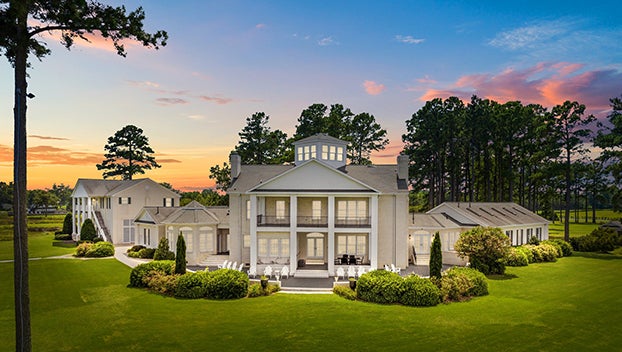Knights’ home singled out for historic preservation
Published 9:07 pm Thursday, May 18, 2017

- HISTORIC HONOR: Thursday, Century 21 realtor Scott Campbell (left) presented the annual Rena K. Terrell award for residential historic property to Vann and Colleen Knight (center), with the help of City of Washington community development planner Emily Rebert (right). The Knights own the Franklin-Bryant House on East Main Street, a 121-year-old home that is featured on Washington Haunts’ ghost tour. (Vail Stewart Rumley/Daily News)
In a short year, Vann and Colleen Knight have turned a historic East Main Street home around, reviving the Franklin-Bryant House — with a little help from an unusual friend.
It’s the exterior work that caught the eyes of City of Washington community development planner Emily Rebert and Scott Campbell, a Washington resident invested in historic preservation, leading the two to recognize the Knights with the Terrell award for a residential property. Named for one of Washington’s founding historic preservationists, Rena K. Terrell, in 2015 Rebert and Campbell reinstated the annual awards to property owners who make the extra effort to preserve Washington’s history.

GOING UP: Double balusters with millwork tops line the central hall staircase, fluted trim punctuated by rosettes frames the front living room door and chair rails are just a sample of this Victorian-era home’s woodwork.
At 121 years old, the Knights’ home has a lot of history. On first impression, the front porch’s ornate spandrels and brackets, supported by turned columns, speak of the Victorian era, as does a gabled roofline that the years and additions to the home have modified. A new coat of paint — yellow, trimmed in white — has created a sunny spot on the south side of the street.
“They did a great job on the exterior,” Campbell said. “(The work they’ve done) affects everyone in a positive way.”
The work doesn’t stop at the exterior. Inside is just under 4,000 square feet of house equaling 19 rooms that cover three floors. When they purchased the property last year, there were ceilings that needed to be ripped out entirely, hardwood floors that had to be refinished, a treacherous entry to the kitchen through the butler’s pantry where the floor had sunk, leaving an 8-inch gap between wall and floor.

FLOWERS FOR MOM: A Mother’s Day gift of roses sits on the granite island of the Knights’ kitchen. In the background, stained and sealed 5 ½-inch tongue-in-groove cypress plank countertops, milled by Vann Knight’s cousin, a Georgia lumber mill owner, can be seen.
Amazingly, the house was sound. Even the sunken butler’s pantry floor was half a day’s work moving a foundational pillar and jacking up the floor, from beneath the house, again.
“We heard everyone (working on the house) say they were just amazed at how solid this house was — that we were very lucky,” Colleen Knight said.
Across a 10-foot-by-32-foot central hall and the more formal rooms of the house, original oak floors were sanded and cleaned. Instead of using polyurethane to seal them, the Knights left them as is, simply finishing them with tung oil, an age-old process that has been used to seal floors for centuries.

LIVED IN: “We spend about 90 percent of our waking hours in the kitchen and sunroom area — and the back yard and garden,” Colleen Knight said.
The couple didn’t stop at the cosmetic, however. They stripped out a non-functioning HVAC system and replaced it with a ductless, mini-split system: three outside units, each powering three wall-mounted “heads” in different rooms — each room is its own zone and temperatures can be adjusted as needed.
“It runs all the time, but it just ramps up when it needs to heat or cool more, then ramps down when the room reaches the temperature,” Vann Knight said. “With the tall ceilings, it would have cost a fortune to run heat and air. These units are 40 percent more efficient than central heat and air.”
Heart of pine floor planks were replaced in the less formal areas of the house and kitchen countertops remade with stained and sealed 5 ½-inch tongue-in-groove cypress planks and were milled by Vann Knight’s cousin, a Georgia lumber mill owner — a good thing, as new countertops were not in their budget and Vann Knight’s parents delivered them to their doorstep.
“We couldn’t have gotten a better deal,” Vann Knight laughed.
Throughout all the renovations, the Knights have had the assistance of a rather interesting source. The Franklin-Bryant house is actually on Washington Haunts’ historic ghost walk led by Terry Rollins, and it’s rumored that a cigar-smoking spirit still inhabits the home.
“I’ll be honest — when they told me the house was haunted I didn’t believe it,” Colleen Knight said. “But now I’m an absolute believer.”

HIDDEN STORIES: This book case was once an exterior side door, but is now an architectural feature in a home with plenty of history. Behind the bookcase, an addition of a place of business (either doctor or lawyer) built by a long-past owner has become a mother-in-law’s suite of a living room, soon-to-be kitchen/dining area and bedroom.
It’s not just the fact that one of their dogs refuses to walk upstairs on his own (as did the dog of the previous owner); it’s that every major problem in the house that could have led to eventual disaster has been pointed out in rather unbelievable ways. A patch of inexplicably non-drying ceiling paint turned into the discovery that the floor beneath a second-floor bathroom’s clawfoot tub was unsupported. The bathroom had no running water, but the first time the tub would have been filled, it would have plunged through the ceiling.
Another time, recently inspected for termites and having none, termites suddenly set up shop in floor planks, which is not so unusual, but when termite inspectors came back to have a look, they discovered live wires, shooting sparks, beneath the floor in that exact spot. It was disaster narrowly avoided.
But nothing competes with the day that five people — the Knights, contractor Timmy Griekspoor, the housepainter and one of Griekspoor’s contemporaries — were discussing replacing one of the home’s original panes of wavy glass, which had been broken when the painters’ scaffolding had been moved earlier in the day. The Knights insisted they try to find glass of the same era to replace the broken pane, as opposed to replacing it with a new pane. Just as Griekspoor’s associate said he was working on a house of the same era and could get the Knights all the wavy-glass panes they wanted, they all heard glass breaking from the other side of the house. On investigation, they found an upstairs window pane had been shattered from the inside (there was no one in the house) and glass lay in the driveway. The strange thing was that the now-broken pane was the only other one, of all the home’s windows, that had ever been replaced with new glass.
“We just feel like there probably a presence here in the house, but it’s benevolent,” Colleen Knight said.
“We’ve felt like the house was telling us what needs to be done,” Vann Knight added.
The Knights will be paying close attention to that otherworldly advice as they continue to restore the Franklin-Bryant home, but right now, the addition of a Terrell award for their work is a nice surprise.
“We didn’t know such a thing even existed so we were very, very pleased to be recognized for it,” Vann Knight said.

CLOSE UP: Victorian design is known for its generous mill work such as the fretwork spandrels featuring ball and dowel punctuated with turned columns.





